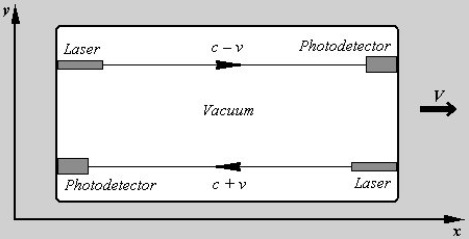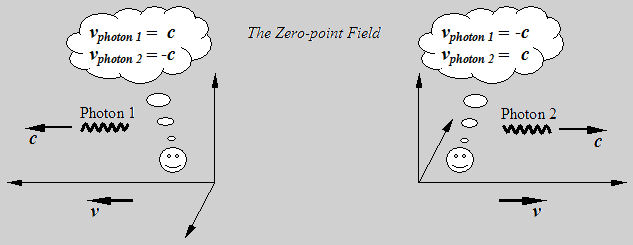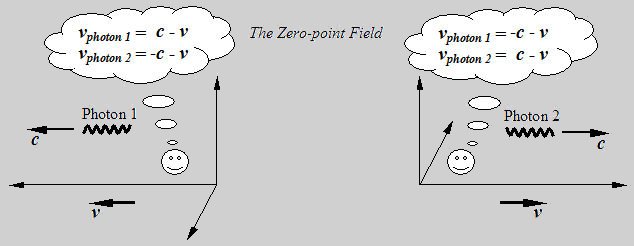| Comments: post@finaltheories.com | |
|
|
Black holes must be able to explode, since we otherwise wouldn't exist! |
|
Deduction of the Theory | Mass and Energy | Evaluation of the Theory | Test of the Theory |
| Proof: Special Relativity is Wrong |
|
The Structure and Composition
of the Cosmos The zero-point field (also called the vacuum state) is the quantum state with the lowest possible energy. The zero-point field normally contains no physical particles, but consists of transient electromagnetic radiation and particles that pop up and disappear. According to the Quantum Ether Theory, the relativistic physical phenomena such as the length contraction and time dilation occur when solid bodies have a velocity relative to the zero point field, and thereby a velocity relative to the propagation speed of the virtual particles that hold the bodies together. Furthermore, since
the traveled length is a function of time, a material length
contraction will seemingly give rise to a "time
dilation", but the speed of the passing of
time has not changed. This means that the time axis is just as
linear as the three space coordinates. The clocks may however
be wrong because of a length contraction. This is no coincidence. Already
around the year 1862, Maxwell calculated the propagation
velocity of electromagnetic waves. This speed proved to be
very close to the speed of light, why Maxwell wrote: "We can
scarcely avoid the conclusion that light consists in the
transverse undulations of the same medium which is the cause
of electric and magnetic phenomena." (J J O'Connor and E F
Robertson, James Clerk Maxwell, School of Mathematics and
Statistics.)
If we compare the theory with the observations of our own Universe, the theory provides an explanation of all the outstanding issues - as for instance dark matter and dark energy. |
The Structure and Composition of the Cosmos The Quantum
Ether Theory
The Structure and Composition of the Cosmos is sold under the name Cosmos and Universes. You can find the thesis by clicking on the book: 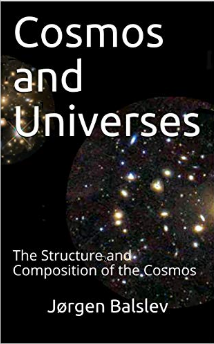 and at Academic Books:  The
Euclidean Cosmos Theory
|
|
|
|
|
The Euclidean Cosmos Theory According to the theory, the Cosmos
consists of an infinite space where all the matter and
energy are collected. When we look at the distribution
of the matter and energy, we assume that the Cosmos
has existed for an infinitely long time, that matter
and energy is constant, that the space is Euclidean,
and that matter and energy are quantized - and
therefore cannot end up as a singularity. The
gravitational force will then produce a distribution
in the infinite flat space, where matter and energy
assembles into larger and denser structures,
until a state of equilibrium arises in the Euclidean
space.
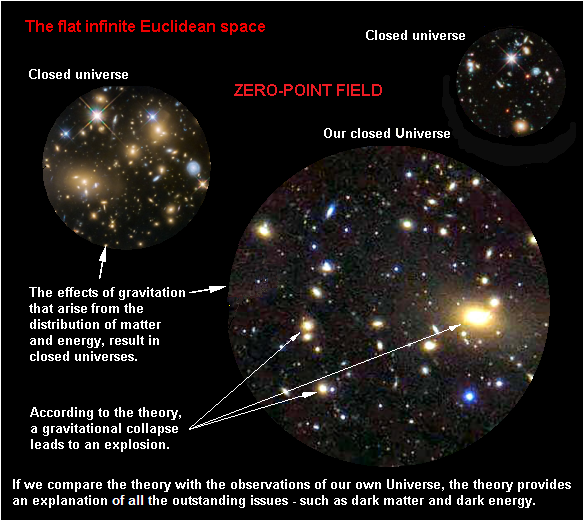
A black hole may start as a neutron
star, or it may as a result of accumulation of matter
reach a density where neutrons are generated at its
center, such that the interior of the black
hole becomes a neutron star. When the external pressure
due to
accretion of matter gets
high
enough, the neutrons at the center of the black hole may
cross the Tolman-Oppenheimer-Volkoff limit, and thereby
undergo a first-order phase transition. Such a phase
transition from neutrons to a quark-gluon-plasma result
in a collapse of the neutron star and a releases of a galore
of energy. Since the
difference in mass between a neutron and the
resulting two down quarks and the up quark is
equal to 1.65 x 10-27
kg, each neutron releases an energy equal to
928 MeV. The splitting of neutrons into quarks and gluons is the largest possible explosion in the universe, which takes place inside a black hole, since the quarks and gluons only can exist separately under the extreme pressure that is found there. Since the free quarks are not bound together by forces that propagate with the final velocity of light, the quarks can achieve a velocity that make them able to leave the neutron star in the direction of rotation. When the quarks leaves the black hole, the pressure falls drastically during the creation of a quark-gluon-plasma and a galore of subatomic particles such as photons, and leptons. In the initial jet of
quarks, photons, and
leptons, the temperature will exceed 1012 K. However, during the following
expansion the jet will experience a continuous cooling,
and after about a microsecond, the temperature may drop so
much, that the free quarks and gluons assemble into
protons and neutrons, and after some minutes atomic nuclei
such as deuterons, and alpha particles may be created. The protons will most likely end up as cosmic rays or as hydrogen in the interstellar medium, while the electromagnetic radiation, if it is not stopped, may reach the farthest regions of the closed Universe before the radiation gradually turns around as cosmic microwave background radiation, which has become red-shifted during its journey through the intergalactic plasma of the closed Universe. Such
explosions at the center of the black
holes are the
largest regenerative
processes in the universe, where a
regenerative process is defined as a
process that transforms heavy elements
into lighter ones. This
is however not the only regenerative processes in the universe,
they may for example also be produced by the merger of black
holes, neutron stars, or dwarf stars. And
since
the regenerative processes get
proportionally more active, when
the galaxies get larger, there is
an upper limit to the size of the
galaxies.
In this way the regenerative
processes deliver energy to the life-cycle of
mass and radiation in the universe, where the
new energy often ends up as nebulae, from
which new stars are born, or as the cosmic
microwave background. The gas nebulae are the
first step on the road, of stars, giants,
white dwarfs, supernovae, neutron stars, and
black holes, where the energy once again ends
up at the center of the galaxy. As the cosmic
microwave background reflects the regenerative
processes, it reflects in this way the
structure of the universe with the great walls
and large voids.

The final result is that matter
accumulates into universes, where the matter and
energy during eons assemble into Great Walls,
which mainly consist of galaxies. Each of the
galaxies has a black hole at the center where the
largest regenerative processes take place,
whenever the black hole gets the right size. The
regenerative processes deliver thereby energy to
the life-cycle of mass and energy in the universe,
where the new energy may end up as nebulae from
which new stars are born, or as cosmic radiation. As the cosmic microwave background
reflects the regenerative processes, it reflects in
this way the structure of the universe with the great
walls and large voids. Finally, since the universe is
closed it can be regarded as a black hole, which
beyond a certain size, cannot hold on to matter and
energy. Since the density of matter and energy in our
Universe is estimated to 3 x 10-28
kg/m3,
the radius of the closed Universe will be about 1.7 x 1026
m. |
There are two observations that are of utmost importance for the structure and composition of our Universe: The first observation is, that quarks cannot be isolated under normal pressures, but promptly create two new quarks, when they are separated. This means, that the most powerful subnuclear reaction is the splitting of neutrons into quarks, which only is able to generate an Active Galactic Nucleus - but never a Big Bang. The second observation is that light becomes red-shifted when it traverses a sparse hot plasma, as for instance the astrophysical plasma. This means that the red-shift is not a consequence of the expansion of our Universe, so our Universe is almost static. This static state arise as an equilibrium between the spread of matter and energy by stars, supernovae and active galactic nuclei, and the collection of matter and energy by the gravitational force.
|
|
|
|
|
The
Length Contraction and Time Dilation are the result
of the Velocity relative to the Zero-Point
Field F = C q1q2/r2, where F is
the force, r
is the distance between q1
and q2
- and C
= 1/(4??0) is
a constant. The two particles is then set in motion in the direction from q1 to q2, with the velocity v relative to the zero-point field. Since both the forces and the distance between the charges may have changed as a result of the movement relative to the field, we write F' = C q1q2/r'2. As the forces propagate with the speed of light, c, the distance the force must travel from q1 to q2 becomes to the first order r1 = ct + vt (since the charge q2 moves away from q1). The distance the force must travel from q2 to q1 becomes to the first order r2 = ct - vt (since the charge q1 approaches q2). We thus find
F'
= C q1q2/r'2
= Cq1q2/[r1r2]
= C q1q2/[(ct
+ vt)(ct - vt)] = C q1q2/[ct(1
+ v/c)ct(1 - v/c)] This is the
Lorentz contraction, or the relativistic length contraction,
which occurs when a body moves relative to the zero-point
field. At the same velocity in the two systems, we find that r/t = r'/t' = r(1-v2/c2)½/t'
1/t
= (1-v2/c2)½/t' Since the distance becomes shorter in the moving system, the time it takes to travel the distance, at the same speed, becomes correspondingly shorter. As the time is reduced by exactly the same factor as the length, the time will pass just as fast in the moving system as in the stationary system. It means, that the time is the same in the two systems. However, the clocks may because of the length contraction, which depends on their design and orientation relative to the direction of motion, be affected by their velocity relative to the zero-point field. If we choose to look at the space and
time as a combined space-time, the time axis will be just as
linear as the three coordinate axes. This means that the
space is Euclidean, so the gravitational field cannot be
explained by the curvature of space-time as in Einstein's
general relativity. |
The Length Contraction and Time Dilation are the result of the Velocity relative to the Zero-Point Field |
|
|
|
|
The
Michelson-Morley Experiment
Fíg. The Michelson and Morley experiment. Assume that
the apparatus is moving in the x-direction with the
velocity v
in the zero-point field and that the velocity of light c
is constant in relation to this field. When the apparatus
is at rest relative to the zero-point field, we have: Lx
= Ly =
L. The apparatus consists of atoms that are held together by electromagnetic forces. When the apparatus is in motion relative to the zero-point field, the light and the virtual photons, that constitute the electromagnetic forces, have exactly the same velocity relative to the apparatus. As the apparatus because of its velocity relative to the electromagnetic field shrinks with the factor (1-v2/c2)½ in the direction of motion, there do not arise any changes in the interference pattern, during the motion of the apparatus around the sun. However, if we assume that the velocity of light (c) is constant in relation to any object, independent of the velocity of the object, the length contraction of the object cannot be explained. Because the velocities of the photons, as well as the virtual photons that hold the object together, will always be constant in relation to the object. |
The Michelson-Morley Experiment All bodies that are moving with a velocity relative to the
zero-point field, must be subjected to a length contraction in
the direction of motion, because of their velocity relative to
the propagation speed of the virtual particles that hold the
bodies together.
|
|
|
|
|
Einstein's Theory of Relativity is Wrong
Einstein's relativity is wrong. This can be seen from the following separate reasons, where each of them is enough to overturn the theory. 1st:
One cannot at the same time have a zero-point field
and let all inertial systems be equal. 2nd: Even if the length contractions and time dilations were real according to relativity, it would not be possible to measure any length contractions or time dilations according to the theory of relativity. The theory of relativity is a theory that explains what the lengths and times looks like in a system S' seen from a system S, and conversely, what the lengths and times looks like in a system S seen from a system S'. We assume that when the two inertial
systems S and S' are at rest relative to each other, the
coordinate values in S and S' have the same physical
length, so |x0|=|x0'|
at a relative velocity equal to zero.
Fig. Two inertial systems S and S', with the relative
numerical velocity v. |
Einstein's Theory of
Relativity is Wrong
|
|
|
|
|
Einstein's Special Relativity Special relativity can be deduced from two
fundamental postulates:* (2) Universality of the speed of light
(Einstein): The speed of light relative to any
unaccelerated observer is c = 3 × 108 ms?1,
regardless of the motion of the light’s source relative to
the observer. Let us be quite clear about this postulate’s
meaning: two different unaccelerated observers measuring
the speed of the same photon will each find it to be
moving at 3 × 108 ms?1 relative to
themselves, regardless of their state of motion relative
to each other. * Bernard F. Schutz: "A
First Course in General Relativity", Second Edition,
Cambridge University Press, 2009. (A widely used textbook in
General Relativity.)
In June 2001, NASA launched a CMB space
mission called WMAP (Wilkinson Microwave Anisotropy Probe).
From the CMB data, it is seen that our local group of
galaxies appears to be moving at 369±0.9 km/s relative to
the reference frame of the CMB. This is in accordance
with Stefan Marinov's measurement of the velocity of the
experimental equipment relative to the zero-point field,
which he measured to 362±40 km/s. Ad. 2. Universality of the speed of
light The same photon, e.g. Photon 1, cannot, at one and the same time, have exactly the same velocity c in relation to the zero-point field and the two inertial systems, with two different velocities.
Since Einstein's Theory of Relativity is wrong, many of the theories that are based on Einstein's relativity are also wrong. In connection with space it means especially that we can ignore the existence of singularities, and the curvature of space, why space is Euclidean. |
Einstein's
Special Relativity
|
|
|
|
|
Evaluation The
Faculty of Science at the University of Copenhagen will
not accept the thesis until it has been approval by a
third party. Your institute or publishing house, if any,
could be that third party! |
Evaluation |
|
To the Top © Jørgen Balslev 2010 |



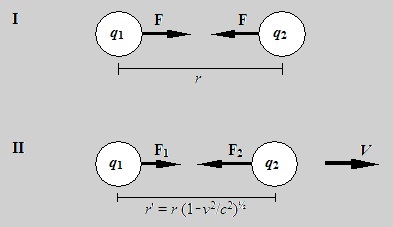
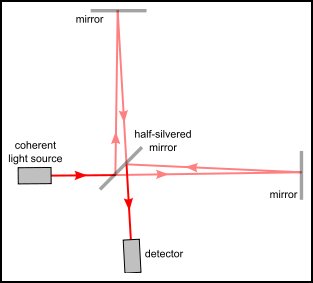
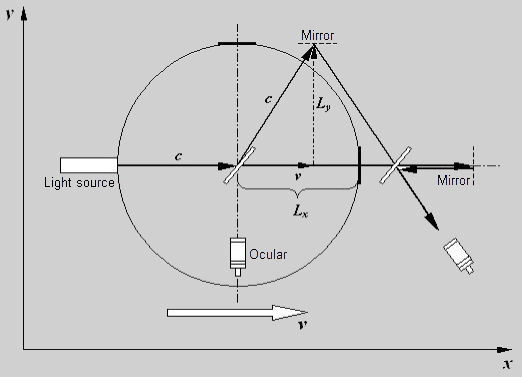
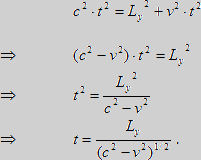
 .
.
 .
. ,
, .
.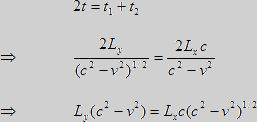 .
.
 .
.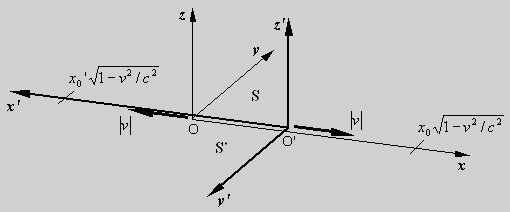
 because of the length
contraction, and seen from S' the length of
coordinate
because of the length
contraction, and seen from S' the length of
coordinate  . Therefore,
. Therefore, 